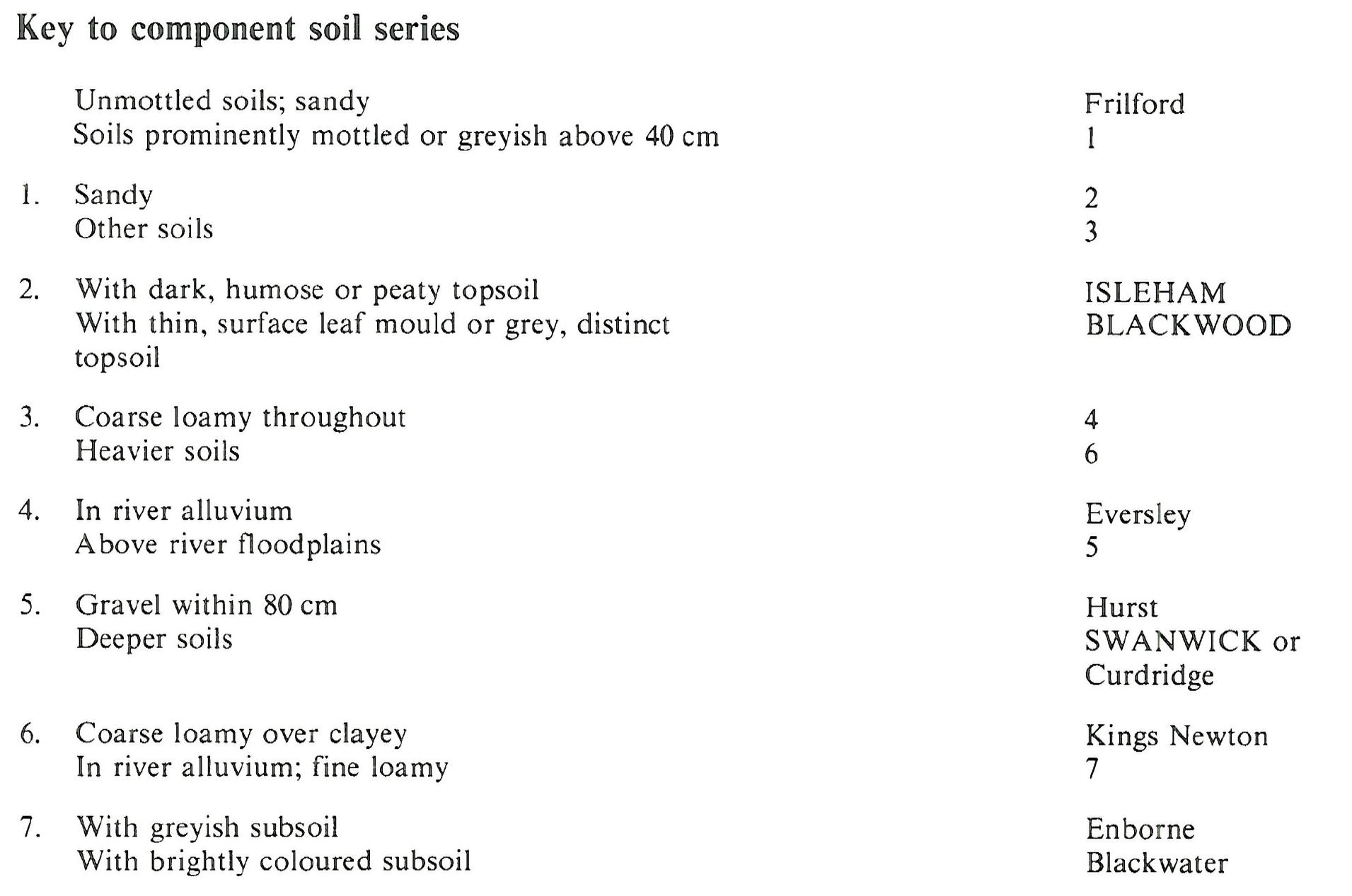
Soil Associations
0841c SWANWICK
Soil and site characteristics
Deep permeable coarse loamy and sandy soils some with peaty surface horizons affected by groundwater.
Geology
Sandy and loamy drift
Cropping and Land Use
Permanent grassland and wet lowland heath and woodland habitats; some arable cropping.
Component soil series
| Subgroup | Series name | Percentage | WRB 2006 link |
|---|---|---|---|
| 8.41 | SWANWICK | 50% | Luvic Gleysols |
| 8.21 | BLACKWOOD | 15% | Arenic Mollic Gleysols |
| 8.61 | ISLEHAM | 10% | Arenic Mollic Gleysols |
Covers 54 km2 in England and Wales
Soilscapes Classification
| 22 |
Loamy soils with naturally high groundwater |
0841c SWANWICK
Detailed Description
This association consists of permeable coarse loamy and sandy soils affected by fluctuating groundwater in sandy and loamy drift containing flints. It is found on gently sloping land in valleys in Berkshire, Hampshire and Surrey. The drift is principally Head derived from nearby outcrops of Bagshot and Bracklesham Beds or from stony river terrace deposits. In broader valleys, for example, that of the Blackwater, narrow strips of alluvium and small patches of peat are included.
The association occurs mainly south and east of Reading. Similar land occurs west of Woking and there is a small delineation near Hythe, Hampshire. Swanwick series, coarse loamy typical argillic gley soils, is most frequent with typical sandy gley soils, Blackwood series, where sands are exposed on adjacent slopes; Isleham soils, formerly called Netley series, are typical humic-sandy gleys confined to uncultivated land. All the common soils are greyish throughout with various amounts of ochreous mottling or banding. Secondary iron or ferri-manganiferous deposition in the form of nodules, partially cemented hard pans or brightly-coloured subsoil horizons is a common feature. Kings Newton soils , with slowly permeable clayey subsoils beneath coarse loamy upper layers, are common on adjacent slopes where the drift is thin. Also included are some Frilford and Bursledon soils on drier sites; Eversley, Enborne and Blackwater soils in alluvium; Hurst series on river terraces; and Curdridge series at flushes.
Most land has Swanwick or Blackwood soils with Kings Newton and Bursledon series upslope in places; Isleham series usually replaces Blackwood soils in woodland and on heathland. On flat alluvial land, fine loamy Enborne, coarse loamy Eversley and the ferruginous Blackwater series are present adjacent to streams, locally interspersed with small patches of peat. The coarse loamy Curdridge series occurs around flushes on drift-free footslopes often accompanied by Blackwater series on adjacent flat land. Frilford soils are confined to low dry sandy mounds and coarse loamy over gravelly Hurst soils are developed on small low-lying terraces near Wokingham and Chobham. Occasional sandy Lakenheath soils have been identified under wet heathland, for example on Wisley Common. The proportions of component soils are different in south Hampshire where Swanwick, Hurst and Shabbington soils are equally extensive.
Soil Water Regime
Groundwater affects the principal soils causing extended and often severe waterlogging for long periods in winter (Wetness Class IV and V). In many places the potential for reclamation is limited by poor outfalls but the soils are permeable and substantial improvements can be achieved where ditch levels can be lowered or pumps can be used. Installation of drains can be difficult and expensive where hard ferruginous subsoil layers are present. Where improved, Swanwick soils are well drained or occasionally waterlogged (Wetness Class I or II) and Blackwood soils become well drained (Wetness Class I). In some districts groundwater is held under pressure below Swanwick profiles by impermeable layers and this should be taken into account when designing drainage schemes. Groundwater reaching this land is often charged with soluble ferrous iron and precipitation of ochre by algae leading to blockage of drainage pipes is a constant hazard. Drained Swanwick soils are non-droughty for cereals and moderately droughty for grass. Grass grown in undrained land may benefit from access to groundwater during dry summers.
Cropping and Land Use
The coarse loamy and sandy Swanwick and Blackwood topsoils are readily cultivated and can bear traffic by machines or stock when dry but when wet they are weak and easily damaged. Where successfully drained, there are few restrictions to cultivation or grazing, but elsewhere land use is much less flexible. Isleham soils, which have moisture retentive humose or peaty topsoils, poach readily even where drained. The main crops are grass and cereals. Small permanent grass paddocks for horses are frequent, but on larger holdings cereal-grass rotations are usual, though yields are often less than average. Regular liming is needed to avoid acidity, especially in the period after reclamation, and levels of available potassium in the soil are low. Near Chobhani, undrained land is used for raising nursery stock.
Tree growth on afforested land is often poor and limited by high groundwater. Water-table control, usually by open drains at 30 m intervals, is necessary before the full forestry potential of this land can be realized. Where the pH is above 5.0, poplar or alder grow well. Much of the land is uncultivated and in rough grassland, woodland or wet heathland. The latter includes part of Wisley Common where the vegetation is dominated by cross-leaved heath (Erica tetralix), purple moor-grass (Molinia caerulea) and rushes (Juncus conglomeratus and J. effusus). Small oligotrophic valley mires are present in some valleys.
0841c SWANWICK
Distribution Map
 |
Note that the yellow shading represents a buffer to highlight the location of very small areas of the association.
Keys to component soil series
South Eastern Region
 |
All information Copyright, Cranfield University © 2025
Citation: To use information from this web resource in your work, please cite this as follows:
Cranfield University 2025. The Soils Guide. Available: www.landis.org.uk. Cranfield University, UK. Last accessed 25/04/2025
